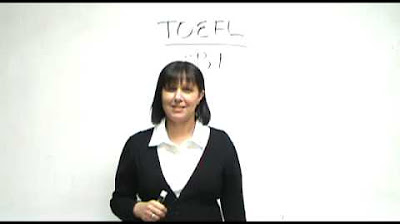Belajar TOEFL Bagi Pemula. Structure - Skill 1 (Subjects & Verbs)
Summary
TLDRThe video script offers an in-depth explanation of the structure and essential skills needed for the TOEFL exam, specifically focusing on the structure and listening expression sections. It details the types of questions, strategies for answering, and key grammatical components like subjects and predicates. The presenter discusses various elements that can function as subjects and verbs in English, including nouns, pronouns, and auxiliary verbs. Through examples and exercises, viewers are guided on how to approach TOEFL questions effectively, emphasizing the importance of understanding sentence structure and grammatical rules.
Takeaways
- 😀 TOEFL Structure Section: The TOEFL structure section contains 40 questions to be answered in 25 minutes.
- 😀 Question Types: There are two types of questions in the TOEFL structure section: Structure (questions 1-15) and Sentence Expressions (questions 16-40).
- 😀 Structure Questions: These involve filling in the blanks in incomplete sentences, selecting the correct word or phrase from multiple-choice options.
- 😀 Sentence Expressions: These questions require identifying the incorrect part of a sentence, often by replacing words or rearranging phrases.
- 😀 Importance of Subject and Verb: A proper English sentence must include at least a subject and a verb, which are key components in answering TOEFL questions.
- 😀 Subject Forms: Common subjects in sentences include nouns, noun phrases, and pronouns. Understanding which can act as subjects is crucial.
- 😀 Verb Forms: The correct verb forms to be used include 'to be' verbs (am, is, are, was, were), modal verbs (can, will, should), and auxiliary verbs.
- 😀 Common Sentence Structures: Sentences often have missing subjects or verbs, and the correct answers involve identifying and filling in these gaps.
- 😀 Importance of Word Forms: Recognizing whether a word should be a noun, verb, or adjective based on context is vital for selecting the correct answer.
- 😀 Practice and Familiarity: Regular practice with sentence structures and grammar will enhance your ability to answer TOEFL questions correctly under time pressure.
Q & A
What is the primary focus of the TOEFL structure section discussed in the script?
-The primary focus of the TOEFL structure section is to test the candidate's ability to understand and apply grammatical structures in English. It includes questions that assess sentence formation, subject-verb agreement, and proper usage of various sentence elements.
What are the two types of questions in the TOEFL structure section as described in the script?
-The two types of questions in the TOEFL structure section are: 1) Multiple-choice questions where the test-taker must select the correct structure, and 2) Listening comprehension questions where the test-taker must identify and correct errors in sentence structures.
What must a sentence in English always contain according to the script?
-A sentence in English must always contain at least one subject and one verb (predicate), as per the script's explanation of sentence structure.
What are the common types of subjects in English sentences mentioned in the script?
-The common types of subjects mentioned are: noun phrases (such as 'the students' or 'the big house'), pronouns (like 'he' or 'they'), and noun clauses (like 'What she said').
How can the subject and predicate be identified in an English sentence?
-The subject can be identified as the part of the sentence that tells us who or what is performing the action, while the predicate includes the verb that describes the action or state of the subject.
What role does 'to be' play in sentence structure as explained in the script?
-'To be' functions as a linking verb, often used as part of the predicate in a sentence. It is essential for forming different tenses and subject-verb agreement, such as 'is', 'are', 'was', and 'were'.
What are the types of verbs that can function as a predicate in a sentence?
-The types of verbs that can function as a predicate include action verbs (like 'run' or 'eat'), linking verbs ('to be'), modal verbs (like 'will' or 'can'), and auxiliary verbs (such as 'have').
What grammatical issue does the script emphasize when completing sentences in the TOEFL structure section?
-The script emphasizes that when completing sentences, it's essential to understand what part of the sentence is missing, such as the subject, predicate, or verb, and to select the appropriate grammatical structure to complete the sentence.
What is the method to answer questions where a sentence is incomplete in the TOEFL structure section?
-The method is to analyze the sentence, identify the missing element (either subject or predicate), and choose the correct answer that logically completes the sentence. The missing part could be a subject, verb, or other components, and you need to select the right grammatical structure.
What examples does the script give for common errors that TOEFL test-takers should be aware of?
-The script provides examples like missing subjects, incorrect verb forms, and inappropriate use of tenses. It also highlights errors in subject-verb agreement, especially when dealing with singular and plural subjects.
Outlines

This section is available to paid users only. Please upgrade to access this part.
Upgrade NowMindmap

This section is available to paid users only. Please upgrade to access this part.
Upgrade NowKeywords

This section is available to paid users only. Please upgrade to access this part.
Upgrade NowHighlights

This section is available to paid users only. Please upgrade to access this part.
Upgrade NowTranscripts

This section is available to paid users only. Please upgrade to access this part.
Upgrade Now5.0 / 5 (0 votes)





